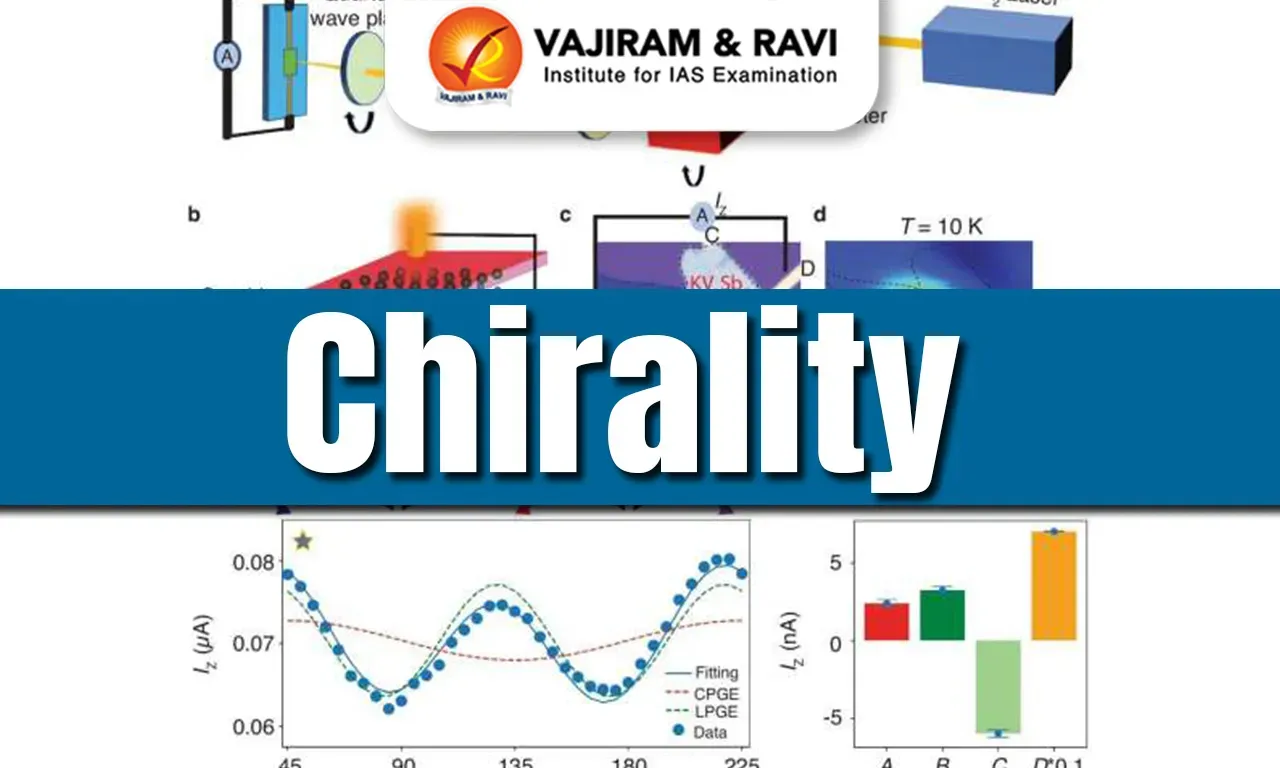Chirality Latest News
Recently, Researchers discovered a chiral quantum state in topological Kagome lattice material (KV₃Sb₅), a material previously believed to be non-chiral, marking a landmark moment in condensed matter physics.
What is Chirality?
- Chirality refers to a property of an object that is not superimposable on its mirror image. It is also known as “handedness”.
- It is ubiquitous, found in amino acids, DNA’s double helix, and spiral patterns in biological organisms.
- Left-handed (L) and right-handed (D) forms are common in molecules and are essential in biochemistry and quantum physics.
What is KV₃Sb₅ and Kagome Lattice?
- KV₃Sb₅ is a bulk quantum material with a Kagome lattice structure, composed of corner-sharing triangles.
- The Kagome pattern, originally from Japanese basket-weaving, is a platform to explore exotic quantum phenomena.
Scientific Method Used
- A newly developed tool, the Scanning Photocurrent Microscope (SPCM), was used to detect nonlinear electromagnetic responses in the material.
- This is distinct from STM (Scanning Tunnelling Microscope), which provides atomic-scale images.
- The SPCM detected handedness in photocurrent, confirming the presence of circular photogalvanic effect (CPGE), a signature of chirality.
Key Findings
- Spontaneous symmetry breaking was observed in the form of a charge density wave (CDW) in KV₃Sb₅.
- When cooled to 4 Kelvin, the material displayed differential response to right- and left-handed circularly polarised light, proving broken inversion and mirror symmetry.
- This is the first confirmation of an intrinsic chiral charge order in a bulk topological quantum material.
Chirality FAQs
Q1. What is Chirality in chemistry?
Ans. Chirality refers to a property where a molecule is not superimposable on its mirror image, often due to the presence of an asymmetric carbon atom.
Q2. What are enantiomers?
Ans. Enantiomers are two non-superimposable mirror-image forms of a chiral molecule.
Q3. Can chirality exist in inorganic compounds?
Ans. Yes, chirality can also exist in inorganic and organometallic compounds, particularly in coordination chemistry.
Source: PHY
Last updated on June, 2025
→ UPSC Notification 2025 was released on 22nd January 2025.
→ UPSC Prelims Result 2025 is out now for the CSE held on 25 May 2025.
→ UPSC Prelims Question Paper 2025 and Unofficial Prelims Answer Key 2025 are available now.
→ UPSC Calendar 2026 is released on 15th May, 2025.
→ The UPSC Vacancy 2025 were released 1129, out of which 979 were for UPSC CSE and remaining 150 are for UPSC IFoS.
→ UPSC Mains 2025 will be conducted on 22nd August 2025.
→ UPSC Prelims 2026 will be conducted on 24th May, 2026 & UPSC Mains 2026 will be conducted on 21st August 2026.
→ The UPSC Selection Process is of 3 stages-Prelims, Mains and Interview.
→ UPSC Result 2024 is released with latest UPSC Marksheet 2024. Check Now!
→ UPSC Toppers List 2024 is released now. Shakti Dubey is UPSC AIR 1 2024 Topper.
→ Also check Best IAS Coaching in Delhi
Tags: Chirality Prelims Pointers upsc prelims current affairs
























